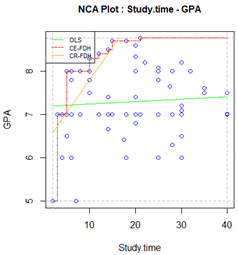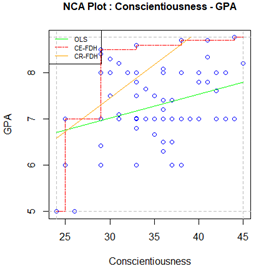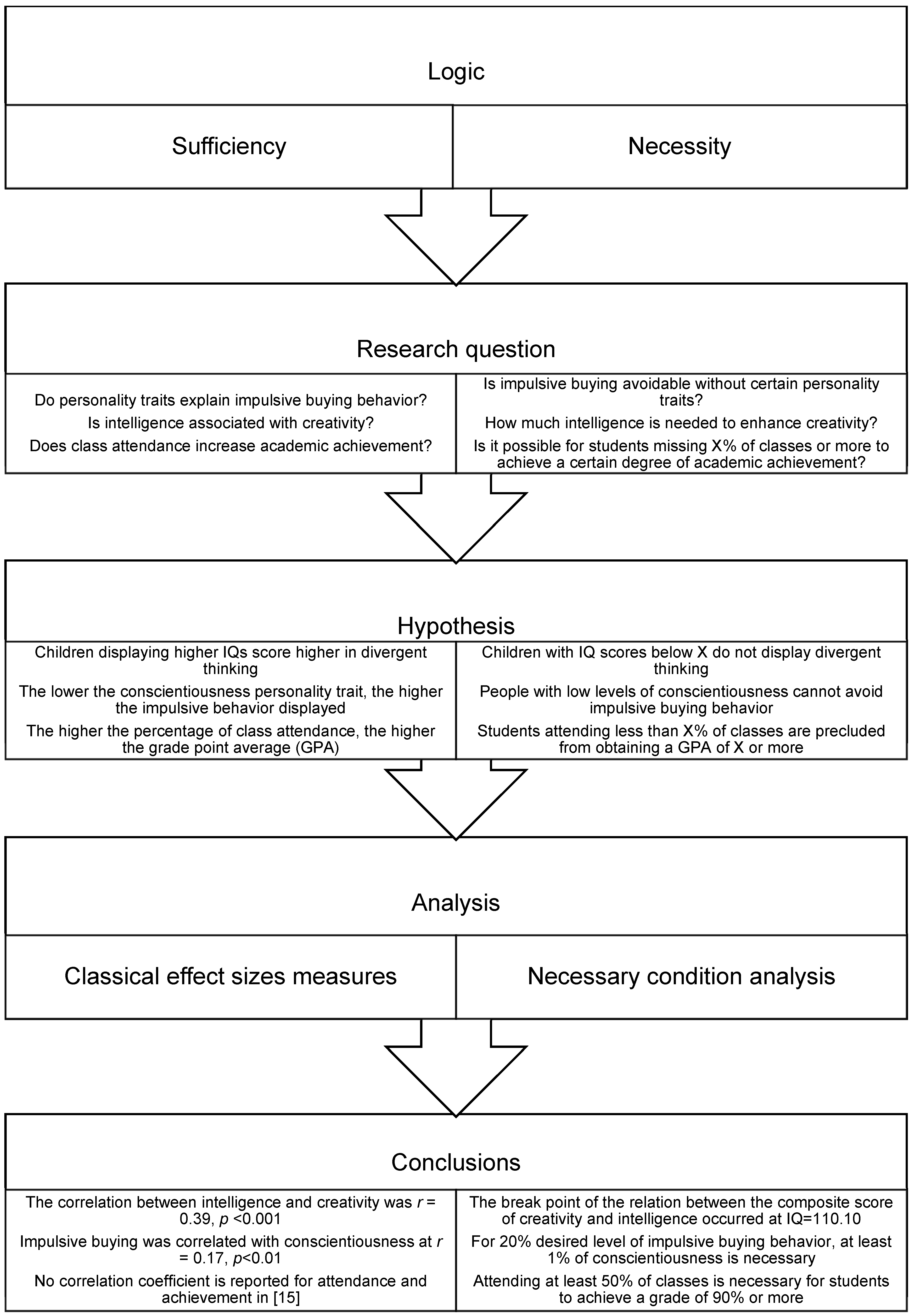Proposing Necessary but Not Sufficient Conditions Analysis as a Complement of Traditional Effect Size Measures with an Illustrative Example
Abstract
:1. Introduction
1.1. Necessary Condition Analysis (NCA)
1.2. Illustrative Example: Is Academic Performance Possible without Previous Achievement, Time Spent Studying, and Conscientious Personality Traits?
- (a)
- The relationship between previous academic performance (as measured by the admission test), time spent studying, and conscientiousness as a personality trait with current academic performance among students enrolled in a face-to-face and an online university based on traditional methods (i.e., Pearson’s r).
- (b)
- If students with poor grades on the admission test, less time devoted to studying, and lower conscientiousness scores were precluded from high academic achievement in one environment (i.e., face-to-face or online) through NCA. We also wished to investigate whether a high ranking on the independent variables made the outcome possible in one or the other university setting, quantifying these effects.
2. Materials and Methods
2.1. Participants
2.2. Instruments
2.3. Procedure
2.4. Data Analysis
3. Results
3.1. Results Obtained through Classical Correlation Analyses
3.2. Example of Results Obtained Using NCA
4. Discussion
4.1. Descriptive and Correlation Analyses
4.2. NCA Results
4.3. Limitations
5. Conclusions
Author Contributions
Funding
Institutional Review Board Statement
Informed Consent Statement
Data Availability Statement
Conflicts of Interest
Appendix A
| Face-to-Face | Online | Complete | ||||||||||
|---|---|---|---|---|---|---|---|---|---|---|---|---|
| 1. | 2. | 3. | 4. | 1. | 2. | 3. | 4. | 1. | 2. | 3. | 4. | |
| 1. Grade point average (GPA) | ||||||||||||
| 2. Admission grade | 0.18 * | 0.39 *** | 0.10 | |||||||||
| 3. Study time | 0.13 | 0.02 | 0.08 | 0.06 | 0.19 ** | −0.10 | ||||||
| 4. Conscientiousness | 0.26 *** | 0.04 | 0.15 | - | 0.32 ** | 0.19 | 0.13 | 0.33 *** | −0.05 | 0.20 ** | ||
| CE-FDH | CR-FDH | |||||||||
|---|---|---|---|---|---|---|---|---|---|---|
| ES | p Value | Accuracy | Outcome Inefficiency | Condition Inefficiency | ES | p Value | Accuracy | Outcome Inefficiency | Condition Inefficiency | |
| Admission grade | 0.14 | 0.220 | 100% | 23.81 | 28.26 | 0.16 | 0.086 | 97.4% | 52.45 | 32.80 |
| Study time | 0.06 | 0.071 | 100% | 47.62 | 51.28 | 0.07 | 0.248 | 99.1% | 66.60 | 57.30 |
| Conscientiousness | 0.14 | 0.158 | 100% | 21.43 | 46.43 | 0.14 | 0.238 | 98.7% | 42.34 | 52.60 |
References
- Funder, D.C.; Ozer, D.J. Evaluating Effect Size in Psychological Research: Sense and Nonsense. Adv. Methods Pract. Psychol. Sci. 2019, 2, 156–168. [Google Scholar] [CrossRef]
- Gignac, G.; Szodorai, E.T. Effect size guidelines for individual differences researchers. Pers. Individ. Differ. 2016, 102, 74–78. [Google Scholar] [CrossRef]
- Pek, J.; Flora, D.B. Reporting effect sizes in original psychological research: A discussion and tutorial. Psychol. Methods 2018, 23, 208–225. [Google Scholar] [CrossRef] [PubMed]
- Cohen, J. Statistical Power Analysis for the Behavioral Sciences, Rev. ed.; Academic Press: New York, NY, USA, 1977. [Google Scholar]
- Cohen, J. Statistical Power Analysis for the Behavioral Sciences, 2nd ed.; Lawrence Erlbaum Associates: Hillsdale, NJ, USA, 1988; ISBN 978-0-8058-0283-2. [Google Scholar]
- Richard, F.D.; Bond, C.F.; Stokes-Zoota, J.J.; Bond, J.C.F. One Hundred Years of Social Psychology Quantitatively Described. Rev. Gen. Psychol. 2003, 7, 331–363. [Google Scholar] [CrossRef] [Green Version]
- Roberts, B.W.; Kuncel, N.R.; Shiner, R.; Caspi, A.; Goldberg, L.R. The Power of Personality: The Comparative Validity of Personality Traits, Socioeconomic Status, and Cognitive Ability for Predicting Important Life Outcomes. Perspect. Psychol. Sci. 2007, 2, 313–345. [Google Scholar] [CrossRef] [Green Version]
- Allen, M.S.; Walter, E.E. Linking big five personality traits to sexuality and sexual health: A meta-analytic review. Psychol. Bull. 2018, 144, 1081–1110. [Google Scholar] [CrossRef]
- Mitchell, M.R.; Potenza, M.N. Addictions and Personality Traits: Impulsivity and Related Constructs. Curr. Behav. Neurosci. Rep. 2014, 1, 1–12. [Google Scholar] [CrossRef] [PubMed]
- Lakens, D.; Scheel, A.M.; Isager, P.M. Equivalence Testing for Psychological Research: A Tutorial. Adv. Methods Pract. Psychol. Sci. 2018, 1, 259–269. [Google Scholar] [CrossRef] [Green Version]
- Rosenthal, R.; Rubin, D.B. A simple, general purpose display of magnitude of experimental effect. J. Educ. Psychol. 1982, 74, 166–169. [Google Scholar] [CrossRef]
- Abelson, R.P. A variance explanation paradox: When a little is a lot. Psychol. Bull. 1985, 97, 129–133. [Google Scholar] [CrossRef]
- Dul, J. Necessary condition analysis (NCA) logic and methodology of “necessary but not sufficient” causality. Organ. Res. Methods 2016, 19, 10–52. [Google Scholar] [CrossRef]
- Hauff, S.; Guerci, M.; Dul, J.; van Rhee, H. Exploring necessary conditions in HRM research: Fundamental issues and methodological implications. Hum. Resour. Manag. J. 2021, 31, 18–36. [Google Scholar] [CrossRef] [Green Version]
- Tynan, M.C.; Credé, M.; Harms, P.D. Are individual characteristics and behaviors necessary-but-not-sufficient conditions for academic success?: A demonstration of Dul’s (2016) necessary condition analysis. Learn. Individ. Differ. 2020, 77, 101815. [Google Scholar] [CrossRef]
- Shahjehan, A.; Qureshi, J.A. Personality and impulsive buying behaviors. A necessary condition analysis. Econ. Res.-Ekon. Istraživanja 2019, 32, 1060–1072. [Google Scholar] [CrossRef] [Green Version]
- Shi, B.; Wang, L.; Yang, J.; Zhang, M.; Xu, L. Relationship between Divergent Thinking and Intelligence: An Empirical Study of the Threshold Hypothesis with Chinese Children. Front. Psychol. 2017, 8, 254. [Google Scholar] [CrossRef] [Green Version]
- Vis, B.; Dul, J. Analyzing Relationships of Necessity Not Just in Kind but Also in Degree. Sociol. Methods Res. 2018, 47, 872–899. [Google Scholar] [CrossRef] [Green Version]
- Karwowski, M.; Kaufman, J.C.; Lebuda, I.; Szumski, G.; Firkowska-Mankiewicz, A. Intelligence in childhood and creative achievements in middle-age: The necessary condition approach. Intelligence 2017, 64, 36–44. [Google Scholar] [CrossRef]
- Garg, N. Workplace Spirituality and Employee Well-being: An Empirical Exploration. J. Hum. Values 2017, 23, 129–147. [Google Scholar] [CrossRef]
- Dul, J. Necessary Condition Analysis (NCA) with R (Version 3.0.2). A Quick Start Guide; Erasmus University Rotterdam: Rotterdam, The Netherlands, 2018. [Google Scholar]
- Dul, J.; van der Laan, E.; Kuik, R. A Statistical Significance Test for Necessary Condition Analysis. Organ. Res. Methods 2020, 23, 385–395. [Google Scholar] [CrossRef] [Green Version]
- Sorjonen, K.; Melin, B.A. Predicting the Significance of Necessity. Front. Psychol. 2019, 10, 283. [Google Scholar] [CrossRef] [Green Version]
- Thiem, A. The Logic and Methodology of “Necessary but Not Sufficient Causality”: A Comment on Necessary Condition Analysis (NCA)*. Sociol. Methods Res. 2021, 50, 913–925. [Google Scholar] [CrossRef]
- Sorjonen, K.; Alex, J.W.; Melin, B. Necessity as a Function of Skewness. Front. Psychol. 2017, 8, 2192. [Google Scholar] [CrossRef] [PubMed] [Green Version]
- Gravetter, F.; Wallnau, L. Essentials of Statistics for the Behavioral Sciences, 8th ed.; Wadsworth: Belmont, CA, USA, 2014. [Google Scholar]
- Berry, C.M.; Sackett, P.R. Individual Differences in Course Choice Result in Underestimation of the Validity of College Admissions Systems. Psychol. Sci. 2009, 20, 822–830. [Google Scholar] [CrossRef] [PubMed]
- Kuncel, N.R.; Hezlett, S.A. Fact and Fiction in Cognitive Ability Testing for Admissions and Hiring Decisions. Curr. Dir. Psychol. Sci. 2010, 19, 339–345. [Google Scholar] [CrossRef]
- Rodríguez-Hernández, C.F.; Cascallar, E.; Kyndt, E. Socio-economic status and academic performance in higher education: A systematic review. Educ. Res. Rev. 2019, 29, 100305. [Google Scholar] [CrossRef]
- Nirogini, A.; Yogendra, A. A study on the factors influencing on grade point average (GPA) with special reference to third year commerce and management students of eastern university, Sri Lanka University, Sri Lanka. J. Stud. Manag. Plan. 2017, 3, 409–425. Available online: https://www.researchgate.net/publication/319645230 (accessed on 15 June 2020).
- AlHeneidi, H.; Smith, A.P. Effects of the Internet use on Wellbeing and Academic Attainment of Students Starting University. Int. J. Humanit. Soc. Sci. Educ. 2020, 7, 20–34. [Google Scholar] [CrossRef]
- Poropat, A.E. A meta-analysis of the five-factor model of personality and academic performance. Psychol. Bull. 2009, 135, 322–338. [Google Scholar] [CrossRef] [Green Version]
- Richardson, M.; Abraham, C.; Bond, R. Psychological correlates of university students’ academic performance: A systematic review and meta-analysis. Psychol. Bull. 2012, 138, 353–387. [Google Scholar] [CrossRef] [Green Version]
- Trapmann, S.; Hell, B.; Hirn, J.-O.W.; Schuler, H. Meta-Analysis of the Relationship between the Big Five and Academic Success at University. Z. Psychol. J. Psychol. 2007, 215, 132–151. [Google Scholar] [CrossRef] [Green Version]
- Broadbent, J. Comparing online and blended learner’s self-regulated learning strategies and academic performance. Internet High. Educ. 2017, 33, 24–32. [Google Scholar] [CrossRef]
- Li, L.-Y.; Tsai, C.-C. Accessing online learning material: Quantitative behavior patterns and their effects on motivation and learning performance. Comput. Educ. 2017, 114, 286–297. [Google Scholar] [CrossRef]
- Siddiquei, N.L.; Khalid, R. The relationship between Personality Traits, Learning Styles and Academic Performance of E-Learners. Open Prax. 2018, 10, 249–263. [Google Scholar] [CrossRef]
- John, O.P.; Donahue, E.M.; Kentle, R.L. The “Big Five” Inventory-Versions 4a and 54; Institute of Personality and Social Research, Berkeley University of California: Berkeley, CA, USA, 1991. [Google Scholar]
- Dul, J. Conducting Necessary Condition Analysis for Business and Management Students; Sage Publications: London, UK, 2019. [Google Scholar]
- Rudakov, V.; Roshchin, S. The impact of student academic achievement on graduate salaries: The case of a leading Russian university. J. Educ. Work 2019, 32, 156–180. [Google Scholar] [CrossRef]
- Tebaldi, E.; Beaudin, L.; Hunter, J.-G. Re-assessing the impact of academic performance on salary level and growth: A case study. Appl. Econ. Lett. 2016, 24, 804–808. [Google Scholar] [CrossRef]
- Schiller, V.F.; Dorstyn, D.S.; Taylor, A.M. The Protective Role of Social Support Sources and Types against Depression in Caregivers: A Meta-Analysis. J. Autism Dev. Disord. 2021, 51, 1304–1315. [Google Scholar] [CrossRef] [PubMed]
- White, S.; Foster, R.; Marks, J.; Morshead, R.; Goldsmith, L.; Barlow, S.; Sin, J.; Gillard, S. The effectiveness of one-to-one peer support in mental health services: A systematic review and meta-analysis. BMC Psychiatry 2020, 20, 534. [Google Scholar] [CrossRef]
- Broadbent, J.; Poon, W. Self-regulated learning strategies & academic achievement in online higher education learning environments: A systematic review. Internet High. Educ. 2015, 27, 1–13. [Google Scholar] [CrossRef]
- Xu, J.; Núñez, J.C.; Cunha, J.; Rosário, P. Online Homework Distraction Scale: A Validation Study. Psicothema 2020, 32, 469–475. [Google Scholar] [CrossRef]
- David, F.N. Tables of the Ordinates and Probability Integral of the Distribution of the Correlation Coefficient in Small Samples; Cambridge University Press: Cambridge, UK, 1938. [Google Scholar]
- Schönbrodt, F.D.; Perugini, M. At what sample size do correlations stabilize? J. Res. Personal. 2013, 47, 609–612. [Google Scholar] [CrossRef] [Green Version]
- Bonett, D.G.; Wright, T.A. Sample size requirements for estimating Pearson, Kendall and Spearman correlations. Psychometrika 2000, 65, 23–28. [Google Scholar] [CrossRef]
- Pearson, E.S. Some Notes on Sampling Tests with Two Variables. Biometrika 1929, 21, 337. [Google Scholar] [CrossRef]
- Dul, J.; Van Der Laan, E.; Kuik, R.; Karwowski, M. Necessary Condition Analysis: Type I Error, Power, and Over-Interpretation of Test Results. A Reply to a Comment on NCA. Commentary: Predicting the Significance of Necessity. Front. Psychol. 2019, 10, 1–2. [Google Scholar] [CrossRef] [PubMed]
- Dul, J.; Vis, B.; Goertz, G. Necessary Condition Analysis (NCA) Does Exactly What It Should Do When Applied Properly: A Reply to a Comment on NCA*. Sociol. Methods Res. 2021, 50, 926–936. [Google Scholar] [CrossRef] [Green Version]
| Students Enrolled in the Face-to-Face University | Students Enrolled in the Online University | ||||||||||||
|---|---|---|---|---|---|---|---|---|---|---|---|---|---|
| Mean | SD | Range | 1. | 2. | 3. | Mean | SD | Range | 1. | 2. | 3. | t | |
| 1. | 6.80 | 0.72 | 5.5–9.20 | 7.29 | 0.79 | 5.0–8.76 | −4.20 *** | ||||||
| 2. | 7.80 | 0.71 | 6.00–9.36 | 0.18 * | 6.90 | 0.96 | 5.0–9.60 | 0.39 *** | 7.25 *** | ||||
| 3. | 12.65 | 8.62 | 1–40 | 0.13 | 0.02 | 18.59 | 10.76 | 2–100 | 0.08 | 0.06 | −4.21 *** | ||
| 4. | 31.87 | 5.54 | 17–44 | 0.26 *** | 0.04 | 0.15 | 35.17 | 4.93 | 24–45 | 0.32 ** | 0.19 | 0.13 | −4.61 *** |
| CE-FDH | CR-FDH | ||||||||||
|---|---|---|---|---|---|---|---|---|---|---|---|
| ES | p Value | A | OI | CI | ES | p Value | A | OI | CI | Skewness | |
| Students enrolled in the face-to-face university | |||||||||||
| 1. | 0.29 | 0.002 | 100% | 27.03% | 31.55% | 0.20 | 0.095 | 98.10% | 38.84% | 36.40% | −0.07 |
| 2. | 0.07 | 0.209 | 100% | 40.54% | 51.28% | 0.08 | 0.115 | 98.70% | 62.08% | 57.30% | 0.90 |
| 3. | 0.17 | 0.427 | 100% | 10.81% | 44.44% | 0.16 | 0.357 | 98.10% | 34.54% | 50.84% | −0.27 |
| Students enrolled in the online university | |||||||||||
| 1. | 0.08 | 0.203 | 100% | 26.60% | 43.48% | 0.10 | 0.051 | 92.10% | 57.54% | 51.51% | 0.40 |
| 2. | 0.09 | 0.010 | 100% | 0.00% | 50.00% | 0.11 | 0.048 | 80.30% | 42.08% | 62.18% | 0.34 |
| 3. | 0.17 | 0.004 | 100% | 0.00% | 4.76% | 0.21 | 0.000 | 82.90% | 42.02% | 28.02% | −0.07 |
| Students Enrolled in the Online University (n = 81) | ||
|---|---|---|
| Ceiling Line y = 0.15x + 6.27 | Ceiling Line y = 0.14x + 3.12 | |
| GPA |  |  |
| GPA (%) | Study time | Conscientiousness |
| 0 | NN | NN |
| 10 | NN | NN |
| 20 | NN | NN |
| 30 | NN | NN |
| 40 | NN | NN |
| 50 | 5.2 | 9.9 |
| 60 | 11.7 | 22.3 |
| 70 | 18.2 | 34.7 |
| 80 | 24.8 | 47.1 |
| 90 | 31.3 | 59.6 |
| 100 | 37.8 | 72.0 |
Publisher’s Note: MDPI stays neutral with regard to jurisdictional claims in published maps and institutional affiliations. |
© 2022 by the authors. Licensee MDPI, Basel, Switzerland. This article is an open access article distributed under the terms and conditions of the Creative Commons Attribution (CC BY) license (https://creativecommons.org/licenses/by/4.0/).
Share and Cite
Greco, A.M.; Guilera, G.; Maldonado-Murciano, L.; Gómez-Benito, J.; Barrios, M. Proposing Necessary but Not Sufficient Conditions Analysis as a Complement of Traditional Effect Size Measures with an Illustrative Example. Int. J. Environ. Res. Public Health 2022, 19, 9402. https://doi.org/10.3390/ijerph19159402
Greco AM, Guilera G, Maldonado-Murciano L, Gómez-Benito J, Barrios M. Proposing Necessary but Not Sufficient Conditions Analysis as a Complement of Traditional Effect Size Measures with an Illustrative Example. International Journal of Environmental Research and Public Health. 2022; 19(15):9402. https://doi.org/10.3390/ijerph19159402
Chicago/Turabian StyleGreco, Ana M., Georgina Guilera, Laura Maldonado-Murciano, Juana Gómez-Benito, and Maite Barrios. 2022. "Proposing Necessary but Not Sufficient Conditions Analysis as a Complement of Traditional Effect Size Measures with an Illustrative Example" International Journal of Environmental Research and Public Health 19, no. 15: 9402. https://doi.org/10.3390/ijerph19159402
APA StyleGreco, A. M., Guilera, G., Maldonado-Murciano, L., Gómez-Benito, J., & Barrios, M. (2022). Proposing Necessary but Not Sufficient Conditions Analysis as a Complement of Traditional Effect Size Measures with an Illustrative Example. International Journal of Environmental Research and Public Health, 19(15), 9402. https://doi.org/10.3390/ijerph19159402








